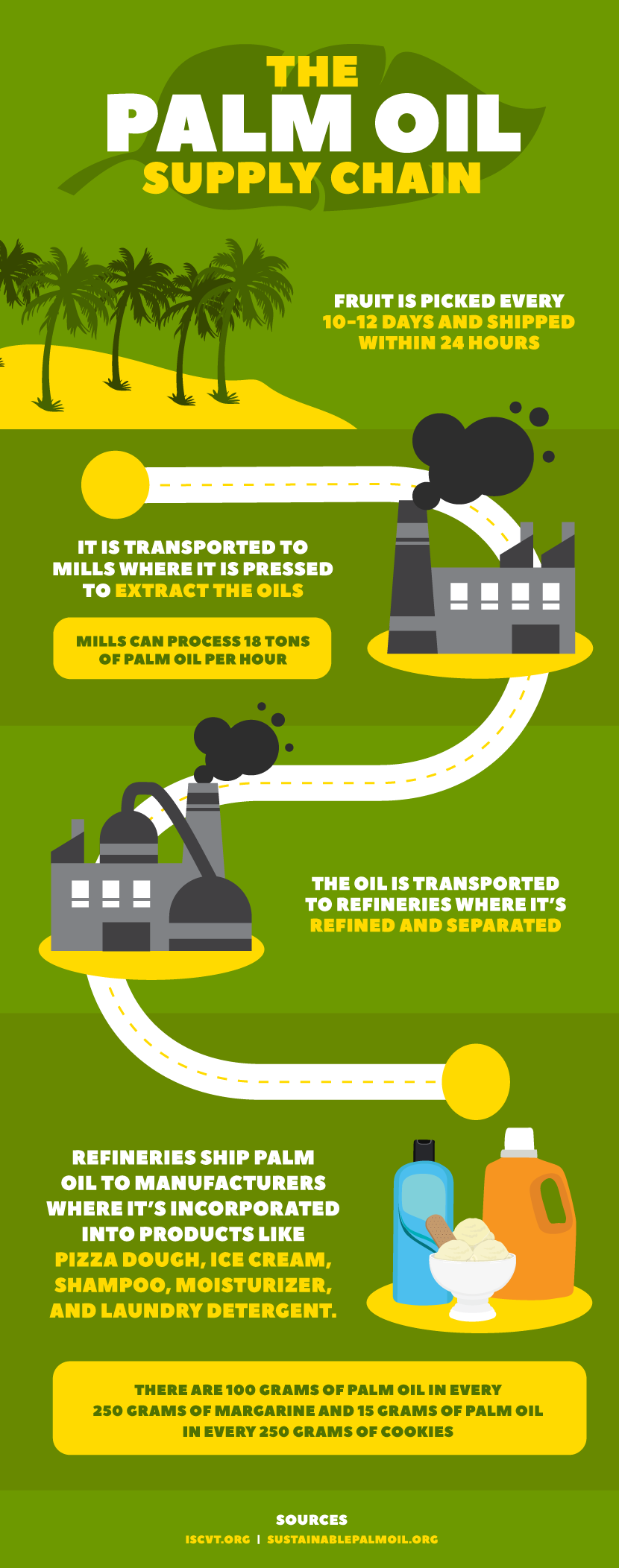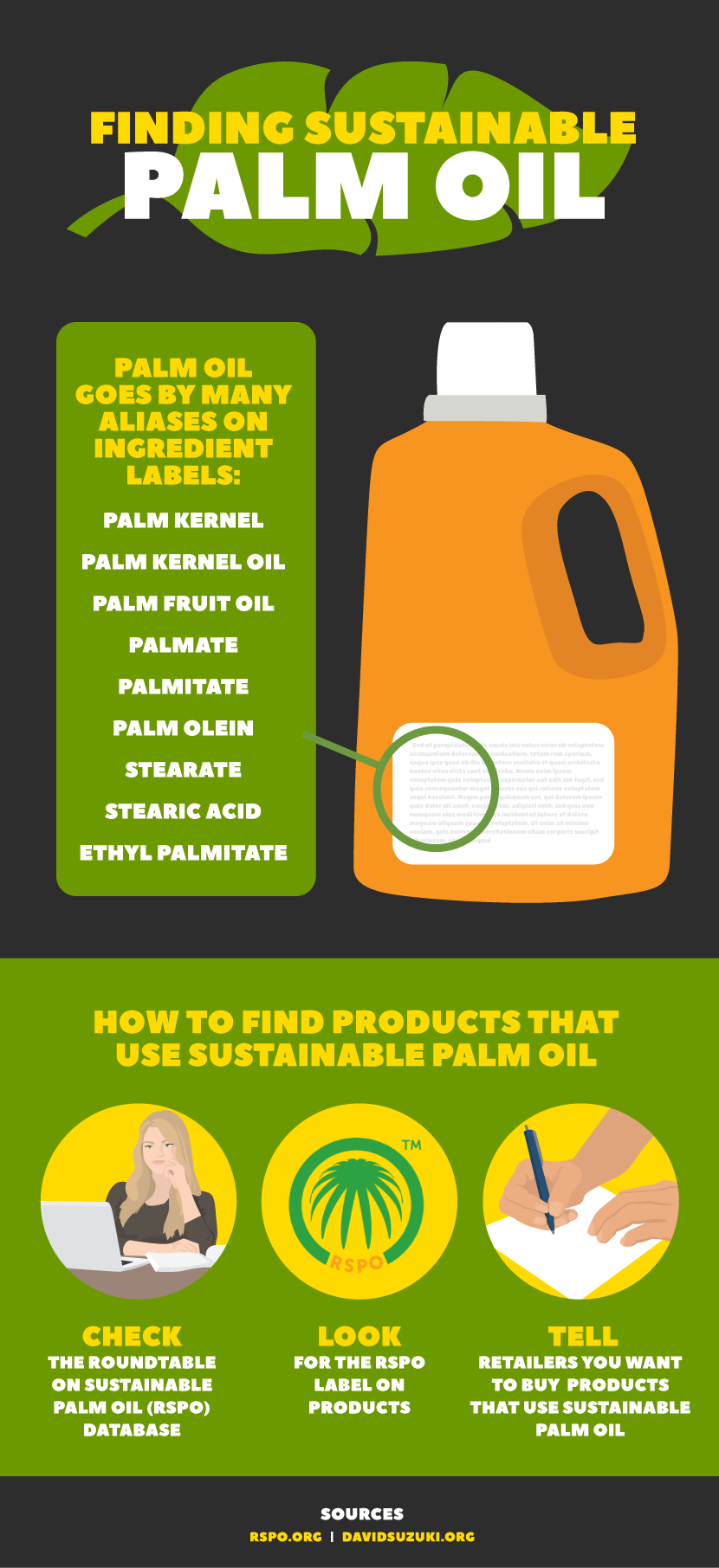The Perils of Palm Oil
How a Popular Product Leads to Deforestation
Your favorite pizza dough, detergent, lipstick, chocolate, and biodiesel have something in common: Most of these products contain palm oil.
Palm oil comes from the fruit on tropical oil palm trees. Producing the edible oil wreaks havoc on the environment, leading to deforestation, habitat degradation, and loss of animal habitat.
The World Wildlife Fund estimates that an area about the size of 300 football fields is cleared each hour in tropical rainforests for palm oil production.

The History of Palm Oil
Palm oil trees grow well in tropical climates with lots of heat and rainfall, including countries in Africa, Asia, North and South America.
Worldwide, 50 million tons of palm oil are produced every year, making it the most widely traded vegetable oil in the world.
The majority of the edible oil is produced in Malaysia and Indonesia.
Palm oil is popular because it is cheap to produce and can be used in a number of different applications.
It has a high melting point and no trans fats, making it a popular cooking oil.
Despite being an oil, it is semi-solid at room temperature. Thanks to its high fat content,
palm oil is also used in non-food products that are designed to moisturize, such as shampoo, lipstick, and moisturizer.
The other reason palm oil dominates the marketplace is that there are few viable alternatives.
Environmental organizations like Greenpeace and World Wildlife Fund have admitted that finding an alternative crop is not a practical solution and instead advocate for industry reforms.
In the meantime, palm oil production is laying waste to the environment.
A 2016 Greenpeace report
found that in Indonesia alone, palm oil has led to the loss of 31 million hectares of forest (more than 76 million acres), an area equivalent to the entire country of Germany.

Environmental Impacts
Palm oil production and deforestation go hand in hand.
To build palm oil plantations, producers clear trees in tropical rainforests, destroying the biodiverse regions.
Deforestation is a significant contributor to climate change; when the forests are lost, carbon is released into the atmosphere, causing global warming.
Removing the native forests often requires burning timber and forest undergrowth, putting significant amounts of smoke into the atmosphere.
In Indonesia and Malaysia, much of the land is on tropical peat soil. This rich soil sequesters carbon. Clearing the land releases that carbon into the atmosphere, which contributes to climate change.
Despite the environmental impact, the Indonesian government plans to convert 45 million acres of rainforest into palm oil plantations by 2020.
The tropical nation has already allowed the deforestation of 25 million acres of peat lands to make room for palm oil plantations.
Wildlife Impacts
Animals living in the biodiverse regions where palm oil is produced are at risk.
Deforestation causes animals to lose their homes. During the production process, animals are often injured or killed.
Orangutans and Sumatran tigers are at risk of extinction and several others species, including the Sumatran rhinoceros,
sun bear, and clouded leopard, are also suffering because of palm oil production.
Cutting down forests also puts animals at risk of poaching.
The World Wildlife Federation reports that the roads built to provide access to vehicles and equipment also provide access for poachers who kill mother orangutans and sell their babies on the illegal wildlife market.
Some are sold as pets and others are used in wildlife tourism parks. Animals that wander into villages while fleeing the destruction are often killed.
Choosing Palm-Oil-Free Products
It’s possible to choose products without palm oil to protect the environment – but identifying which products contain the destructive ingredient is harder than it seems.
On labels, palm oil might be listed as palm kernel, palm kernel oil, palm fruit oil, palmate, palmitate, palm olein, stearate, stearic acid, ethyl palmitate, or several other iterations.
You can also look for products made with sustainable palm oil.

In 2008, the Roundtable on Sustainable Palm Oil developed a certification for sustainable palm oil. To date, 68 growers and 281 palm oil mills producing 11.37 million tons of palm oil have been RSPO-certified.
The criteria require that palm oil does not come from fragile ecosystems or forests containing significant concentrations of biodiversity, including endangered species.
Production must not impact forests where local communities depend on the forest to meet their basic or cultural needs.
To qualify for certification, producers must show minimal use of pesticides and fires, fair treatment of workers, and fulfil a requirement to consult with local communities before development of new plantations on their land.
Palm oil is a versatile ingredient in myriad products, but as this article has shown, the bad outweighs the good.
Shop intelligently and avoid products that contain palm oil, or shop only for certified sustainable palm oil from now on.
Embed the article on your site

